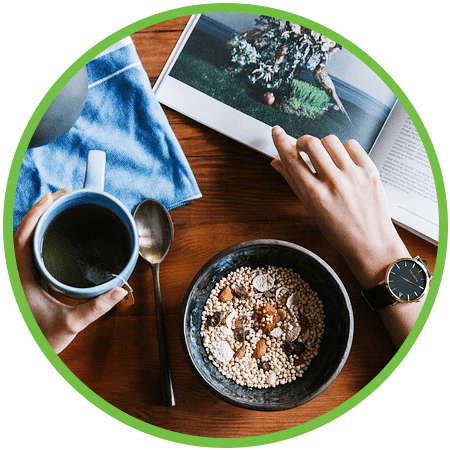
Control Your Menopause Symptoms With a Healthier Lifestyle
There are many physiological and psychological complications associated with menopause. BodyCare Nutrition® Vitality is the foundation for a holistic lifestyle approach to help you address the symptoms of menopause.
This section provides helpful information to improve your nutrition/diet, mood, fitness and appearance whilst you transition through menopause. Please scroll down the four categories below for which section you’d like to know more about.
Foods To Eat And Avoid During Menopause
Evidence has found certain foods, such as soy, may help combat symptoms of menopause, such as weight gain, hot flushes and low bone density. There are also foods which may aggravate your symptoms. Here we explore key food categories and explain why they could be beneficial. Many of these foods have anti-inflammatory properties, which is fantastic!
However, before we start looking at specific foods, let's have a look at the weight loss journey and the impact a healthy gut microbiome has on managing menopausal symptoms.
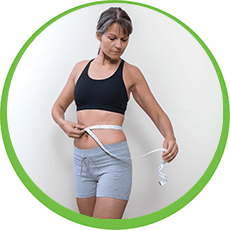
Getting Weight Loss Right
Menopause tends to start with weight gain around your middle, which sneaks up on you. It can be hard to shift, this is why diet and exercise are so important. Weight gain can also increase your blood sugar levels and Insulin resistance. Both weight gain and higher blood sugar/Insulin resistance are linked to the severity of hot flushes and night sweats, in addition to other diseases states such as type 2 diabetes, high blood pressure, high LDL (bad) cholesterol and inflammation.
However, before embarking on any form of dietary change, it is advised to first consult with your doctor, dietician, naturopath or pharmacist. If possible, in conjunction with your healthcare professional, set yourself a realistic weight loss goal. Don’t put too much pressure on yourself. Losing weight should not be a life sentence. In fact, make it easy for yourself. You could a have series of goals, as achieving one builds on the next. And don’t forget the old adage “Failing to plan is planning to fail!”
Remember, no one diet suits everybody. Seeking help, trial and error and some patience will eventually see you triump.
During your weight loss journey you might find the rate at which you are losing weight slows or stalls altogether. This is perfectly natural as your body’s natural instincts go into survival mode. The trick is not to panic or give up. Just continue with your new healthy eating habits or perhaps making a slight adjustment will help you breakthrough to the next weight loss stage.
Tip 1: Consider Time-Restricted (Intermittent) Fasting as a method for losing weight… It is an easy, effective and convenient way for you to burn fat and lose weight. Intermittent fasting helps your body shift from using carbohydrates as an energy source to using fat as the energy source. Fasting increases circulating levels of human growth hormone, which improves health and longevity. Intermittent fasting also helps with Insulin resistance, high blood pressure, high LDL (bad) cholesterol and inflammation. In fact, the first step in losing weight is to get blood glucose and Insulin levels undeer control. One method of intermittent fasting gaining favour is to restrict your eating to a 10 hour window during the day. This may mean skipping the traditional early morning breakfast for a meal (breakfast) mid to late morning and having dinner early evening around 6.00 or 7.00 pm. This means your daily fasting time is longer, which helps improve both blood glucose levels and Insulin sensitivy. Blood glucose and Insulin levels need to be in order for weight loss to occur.
Importantly, BodyCare Nutrition™ Vitality is not a meal replacement. It offers you the flexibility to tailor your food consumption to your own, individual requirements. You can use Vitality with a wide range of dietary strategies such as intermittent fasting, Keto, counting points, counting calories or carbohydrates. And because low GI Vitality helps control glucose levels, it stops sugar cravings and makes you feel full. Vitality’s high protein and fibre levels also assist with this.
Tip 2: Focus on carbohydrate reduction for losing weight… The more carbohydrates you eat and the more often you eat them over 24 hours, the higher and more protracted your blood glucose and Insulin levels will be. This is how Insulin resistance starts. Also, you will find your weight loss will be slower. By reducing carbohydrates you will allow your body to normalise its blood glucose and Insulin levels, which speeds up the weight loss. You will also feel much better within yourself. A trap with eating carbohydrates is that you will want to keep eating. Carbohydrates do not give you that feeling of fullness for long and the higher your blood glucose and Insulin levels are the hungrier you will feel.
TIP 3: Chewing food properly helps you lose weight
Researchers have found chewing food well increases your body’s energy expenditure, which helps you lose weight. While the difference in energy expenditure per meal is small, the cumulative effect gathered during multiple meals, taken over every day and 365 days a year, is substantial.
Three secrets to maintaining the weight loss…
Eighty percent of people who lose weight put it back on.
Here’s some of the secrets used to lose weight and keep it off. More often than not keeping the weight off is about attitude, persevering despite setbacks, reflecting on what life was like before the weight loss and remaining focused on health.
These secrets were uncovered in research published in Obesity: The Journal of The Obesity Society (February 9, 2022).
One of the most impressive findings was how weight-loss maintainers described perseverance in the face of setbacks. Perseverance was essential in overcoming the inevitable setbacks. Setbacks were seen as part of their successful journey and not described as failures. They were seen as a temporary interruption to their journey. Many weight-loss maintainers described getting back on track at the next meal or the next day and measuring overall success based on long-term goals.
As a motivation, successful weight-loss maintainers reflected on what life was like before the weight loss. They cited concerns about mobility, appearance and often feeling tired. They felt the need to make changes so they could lead a healthier, better quality of life.
The third secret to successfully maintaining weight loss is constantly being focused on health. A useful technique for this is tracking food intake. Over time this practice becomes an essential skill within your healthier eating and exercising lifestyle.
Other motivations behind losing weight and keeping it off include the threat of dealing with health issues such as diabetes and heart conditions.
TIP 4: Drink 2 litres of water a day. It is not as bad as it seems as you can include drinking beverages like tea and coffee. Drinking water gives you a feeling of fullness, which helps to stop you from eating more. Drinking water is the perfect accompaniment when practicing intermittent fasting.
Your Gut Health Is So Important
The relationship between your gut and your hormones is a two-way street.
Your gut contains billions of bacteria, known as the microbiome. One collection of gut microbiome is the 'Estrobolome', which supports estrogen metabolism as it affects both the excretion and circulation of estrogen. When your Estrobolome is healthy it ensures the right amount of estrogen is present in your body. An unbalanced microbiome however, called dysbiosis, can cause all sorts of problems for your body, including unpsetting your hormone levels. The relationship also works in reverse – and the shifts in your hormones during menopause can actually change your microbiome’s composition. An unblanced microbiome can cause weight gain.
The good news is, you can give your body the support it needs by improving your gut health. The best way to ensure you have a healthy gut microbiome balance is to consume soluble fibre. A good sources of fibre include peas, beans, citrus fruit, carrots, broccoli, avocados, figs, apples, hazel nuts, oats and abrley to name a few.
It is amazing that supporting your microbiome could actually help menopausal symptoms which researchers previously thought were only controlled by hormones. This opens up a whole new avenue of managing your menopausal symptoms naturally with diet and nutrition as is highly recommended.
Foods To Eat
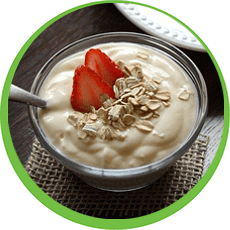
Dairy Foods
The decline in estrogen levels during menopause can increase a woman’s risk of poor bone health, osteoporosis and fractures later in life. Dairy foods, such as milk, yogurt and cheese containing calcium, magnesium and vitamins D and K are important. All are essential for bone health.
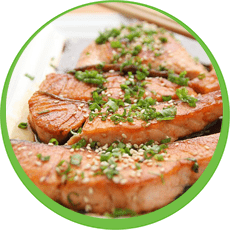
Healthy Fats
Healthy fats, such as omega-3 essential fatty acids (EFAs), may benefit women going through menopause. Omega-3 EFAs are known for their anti-inflammatory activity. Omega-3 EFAs have been shown to have a positive effect on your heart, joints, bones, skin, sleep and mood. Foods high in omega-3 EFAs include fatty fish, such as salmon and anchovies, and seeds like flax seeds and chia seeds.
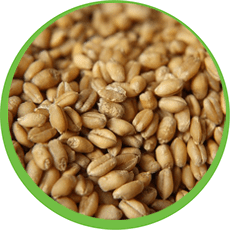
Whole Grains
Whole grains are high in nutrients, including fibre and B vitamins, such as thiamine, niacin and riboflavin. A diet high in whole grains helps reduce the risk of heart disease and diabetes, which may increase during menopause. Whole grain foods include brown rice, whole-grain bread, pasta, barley, quinoa and rye.
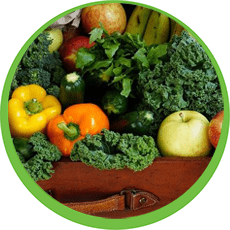
Fruit and Vegetables
Fruit and vegetables are low in calories and are packed with vitamins, minerals, fibre and antioxidants. These nutrients are important, however fibre is special. It is a hormone saviour and protects us from ageing by reducing blood sugar fluctuations, which can play havoc with your insulin levels.
Phytoestrogen containing foods, may help in the reduction of hot flushes and night sweats. Foods that naturally contain phytoestrogens include soybeans, chickpeas, peanuts, flax seeds, barley, grapes, berries, plums and many more. Beverages like green and black tea also contain phytoestrogens.

Quality Protein
The decline in estrogen from menopause is linked to decreased muscle mass and bone strength. As protein is critical to the production of hormones, women should pack plenty of it into their menopause diet.
Foods high in protein include eggs, poultry, lean red meat, fish, dairy foods and beans and legumes including chickpeas, lentils, peas, kidney beans, black beans, soybeans and peanuts. Other non-dairy foods high in protein include broccoli, spinach, asparagus, artichokes, potatoes, sweet potatoes, Brussels sprouts, quinoa, oats and oatmeal. Additionally, you can add Vitality to make delicious smoothies.
Good news for your hair, skin and nails is that collagen is the most abundant protein in your body. The change in hormone levels experiences during menopause can result in a loss of collagen. When your body makes collagen, it combines amino acids — vital nutrients you get from eating protein-rich foods like those mentioned above. So it makes sense to add high protein foods to your diet.
Foods high in calcium and iron are also worthy of a special mention. These include low fat dairy foods, broccoli, legumes, lean red meat, poultry, eggs and leafy green vegetables.
Foods To Avoid
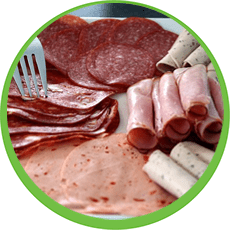
High blood sugar, insulin resistance and metabolic syndrome have been linked to higher incidence of hot flushes, weight gain and poor sleep in menopausal women. So it makes good sense to avoid certain foods.
At the top of the list are highly processed foods. You can generally tell which ones to avoid as they have high calories, carbohydrates (saturated fats and sugar) and sodium. Such foods include packet foods and processed meats like salami and sausages. Check out the nutritional information on their labels before purchasing.
As a general rule try and avoid soft drinks, fast food, biscuits, cake, lollies, chips, crackers, ice cream and some breakfast cereals, or minimise your consumption of them. Small amounts of your favourite foods may be part of your weight-loss plan. Just remember to keep track of the total calories you take in. To lose weight, you must burn more calories than you take in through food and beverages.

It is worth noting that the decline in estrogen increases your risk of developing high blood pressure. Reducing your sodium intake can help lower this risk.
Everything is moderation is also a good policy. This particularly applies to alcoholic and caffeine based beverages. It is believed caffeine and alcohol can trigger hot flushes in women going through menopause. Also, caffeine and alcohol are well known sleep disruptors and many women going through menopause have problems sleeping.
Avoiding spicy foods is a common recommendation for women going through menopause. However, your reaction to spicy foods may be specific to you. It is recommended to avoid spicy foods if they seem to worsen your symptoms.
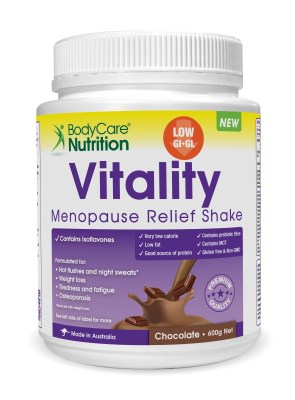
Take Control Of Menopause And Get Your Life Back…
Vitality is available in delicious vanilla, chocolate and coffee flavours, plus a neutral tasting smoothie base.
Feeling Stressed? Help Is At Hand!
There is a strong argument stress plays a role in bringing on menopause and the severity of menopausal symptoms experienced. Who then wouldn’t want to improve their stress levels during midlife?
Another very good reason for better stress management is that it can affect your sleep. And without adequate sleep, it is nigh on impossible to get your hormones and health back in line.

Relaxation Exercise
Sit in a chair or lie on a couch/bed with your eyes closed. Make sure you are in a quiet, peaceful place, where there are no distractions.
Start by focussing on your breathing. Breathing exercises can help lower blood pressure. Take deep, long breaths. Breathe in and out slowly, using a regular rhythm. This will help calm you down.
- Breathe in through your nose (or through your mouth if your nose is blocked). Fill the whole of your lungs with air but without forcing. Put your hands on your stomach and feel them rise and fall.
- Breathe in slowly and regularly, counting from 1 to 5 (don't worry if you can't reach 5 at first).
- Then let the breath escape slowly, counting from 1 to 5. Imagine the stress being breathed away.
- Keep doing this until you feel calm. Breathe without pausing or holding your breath.
The next phase is to relax each muscle in your body. This enables you to relax by letting go of the tension.
As described below, hold the stretch of each muscle group for a few seconds, then relax. Repeat the entire process, in the same muscle group order.
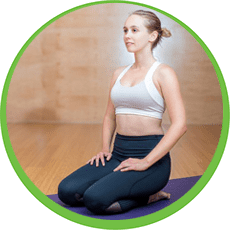
Work up from your feet, through your body, to your face. Continue your deep, slow breathing throughout the entire process. Think of your body relaxing, muscle group by muscle group - really FEEL that calming sensation!
- Feet and legs: Push your toes away from your body, then pull them back, then relax. Tense your calves, then relax. Do the same with your thighs and buttocks. Go gently.
- Abdomen and chest: Breathe slowly and deeply into your diaphragm (below your bottom rib) so that you're using all of your lungs. Then breathe slowly out, allowing your belly to deflate as all the air is exhaled.
- Shoulders: Pull your shoulders up towards your ears (shrug), then relax them down towards your feet.
- Arms: Stretch your arms away from your body, reach out, then relax.
- Wrists and hands: Stretch your wrist by pulling your hand up towards you, stretch out your fingers and thumbs, then relax.
- Neck - gently tilt your head forwards, pushing chin down towards chest, then slowly lift again.
- Face: Push your eyebrows together, as though frowning, then release. Then clench your teeth and let go.
This entire exercise may take 20 to 25 minutes. Make the time to do it. Morning and evening may be best. Your body and mind will thank you. Practising twice a day would be a great start. Over time, you’ll find you can relax in increasingly uncomfortable situations, particularly by applying the breathing phase.

Other Techniques To Relax
TIP 1: Smile... Believe it or not, the act of smiling can lift your mood. Smiling even makes you more of a joy to be around. So if you are feeling a bit low, smile and the world will smile with you! You’ll feel better for it.
TIP 2: Soaking in a hot bath can make you feel better. Research in the peer reviewed journal BMC Psychiatry found sitting in a bath for 15 to 20 minutes twice a week led to significant improvements in depression severity after just two weeks.
TIP 3: Get some house plants. Not only do they help clean the air, research has shown having house plants can reduce feelings of tension and anxiety by 37%, anger by 44% and a feeling of general low mood by 58%.
You may be aware there are many other things you can do to lift your mood. Do things you enjoy doing. Playing good music, exercising (such as going for a walk or run), gardening, dancing in the kitchen, reading a good book or using relaxing aromatherapy scents can all help you relax.
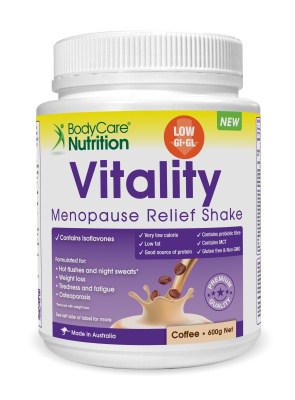
Take Control Of Menopause And Get Your Life Back…
BodyCare Nutrition™ Vitality is the foundation for a holistic lifestyle approach to help you address the symptoms of menopause.
Exercise During Menopause
Exercise during and after menopause offers many important health benefits including weight loss, a healthy body, good mental health and a reduced risk of heart disease, high blood pressure and cholesterol, type 2 diabetes and osteoporosis (bone fractures).
Menopause tends to start with weight gain around your middle, which sneaks up on you. It can be hard to shift, this is why exercise is so important. Not exercising during menopause would be a disaster as your muscle mass decreases with age. You need muscle mass to protect your bones.
If you have not been a regular exerciser, it is recommended to see your healthcare professional before starting any form of exercise.

Goal Setting
Like any fitness routine you first need to set yourself goals. Think about what you want to achieve. Resist the urge to put too much pressure on yourself – just staying healthy and positive is a big triumph. For example, use your energy when you have it, rather than beating yourself up about the times you don’t.
One good technique is to take small steps and gain little wins as you commence your health and fitness journey. This approach gives you the evidence and belief your goals are achievable and is a great motivation. You can then re-evaluate your goals to aim higher.
Research has found you will have far more success setting your own goals and then starting immediately, than if your goals are assigned to you.

Getting Down To Business
Think of exercise as an act of self-care. To make exercising easier, choose exercises you will enjoy doing. You might find joining a gym or fitness group is the way to go. However, doing the gardening and housework also counts. Fortunately, drinking a glass of Vitality will give you the energy to exercise.
Allow 10 minutes of warming-up at the beginning of your session and 10 minutes at the end to warm down. If you can manage to do 150 minutes of exercise per week of enjoyable moderate-intensity exercise, you are well on your way to a healthier life. It will be 150 minutes which offers little inconvenience for you!
There are many different types of exercises you can do and they all offer different health benefits.
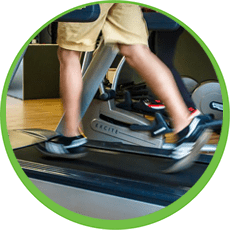
Cardio
Cardio or aerobic exercise is your first line of defence against gaining more weight and starting the weight loss process. Cardio exercise helps you burn calories as well as protect you from other health issues that arise during menopause, such as heart disease and osteoporosis.
Your cardio exercise options are limitless. Here are some examples:
- Brisk walking
- Jogging
- Biking or doing spin class at the gym
- Swimming
- Dancing
If you’re a beginner start off gently and slowly boost the intensity of the exercise as it becomes easier.
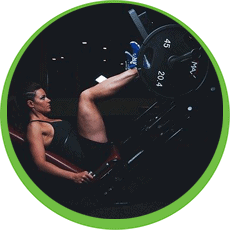
Strength Training
‘Muscle-building’ exercises are particularly important for women going through menopause as they lose bone density and the risk of osteoporosis skyrockets. Strength training exercises will help you build bone and muscle strength, reduce body fat and burn calories more efficiently. Strength training is truly the gold standard for preserving bone mineral density and offsetting muscle mass loss through menopause. The good news is, it's never too late to pick up the weights.
At home, opt for dumbbells and resistance bands. You could even choose to go for a walk with light dumbbells. In the gym, choose from weight machines or free weights. Select a level that is heavy enough to tax your muscles in 12 repetitions and progress from there. You may like to enlist the help of a personal trainer to learn proper technique and prevent injury.

Stretching And Flexibility
It’s important to stretch your muscles before and after a workout session and should be done as part of your daily routine, Stretching preserves your body’s range of motion and keeps your joints flexible. These are two things you lose as you age. When stretching, take care not to overextend your limbs and joints.
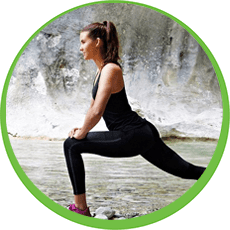
Stability And Balance
Exercises that enhance your body’s ability to stay upright and steady are particularly important as you enter menopause. As you age your balance tends to deteriorate. Balancing exercises improve stability and help prevent falls.
Try simple exercises, such as standing on one leg for a few seconds. You could even try this whilst you brushing your teeth. Another option is balancing yourself against a wall or chair if you are feeling unsteady. Tai chi and yoga can also help.
Pelvic Floor Exercises
When estrogen levels drop, the tissues of the vagina and urethra can lose some elasticity. You can support and strengthen your pelvic floor by (1) standing, lying or sitting straight. (2) Relax your thigh, bottom and lower tummy muscles. (3) Draw in the muscles around your front passage (vagina) and then relax them. (4) Finally draw in the muscles around the back passage (anus) and then relax them. (5) Repeat two to 3 times a day.
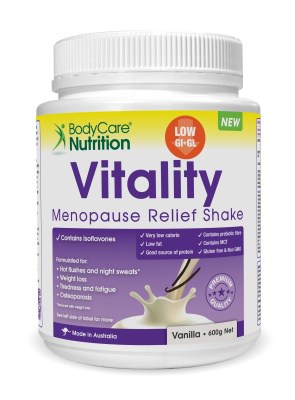
Take Control Of Menopause And Get Your Life Back…
Enjoying both healthy food and exercising will enhance your ability to control menopause!
Ways To Help Your Hair, Skin and Nails…
Due to the menopause transition your body stops producing enough estrogen. This can impact on the health and quality of your hair, skin and nails.
BodyCare Nutrition® Vitality contains nutrients to help you have health healthy hair, skin and nails during menopause. There are also other things you can do to achieve shiny, healthy hair, healthy, youthful looking skin and strong nails.

HAIR (lacklustre, dry and breakable)
- Reduce the use of heat damaging styling products such as straighteners and curling tongs and when using hair dryers avoid using the highest heat setting.
- If you must dye your hair, choose an all-natural hair colour. Artificial chemicals found in dyes and perms can compromise your scalp and hair health.
- Make sure you eat a healthy and varied diet, which includes fruit, vegetables, whole grains and healthy fats.

SKIN (dry, wrinkly, sagging and jowley looking)
- Protect your skin from the sun. This can reduce visible wrinkles and prevent new wrinkles.
- In your diet, address any deficiencies in protein, iron and B vitamins.
- Eat antioxidant-rich foods, which have a protective effect for skin. These skin-friendly foods include carrots, apricots, oranges, green leafy vegetables, tomatoes, soy, berries, nuts and oil fish like salmon.
- Moisturisers help reduce the appearance on fine lines.
- Don’t smoke. Smoking damages collagen and elastin, making your skin look older. Smoking also contributes to wrinkles.
Women who smoke are at twice the risk of premature menopause, i.e. experiencing menopausal symptoms around the age of 40. Therefore, quitting smoking has important benefits during menopause. First, quitting smoking for 10 years minimises the risk of premature menopause. Secondly, smoking contributes to the increased cardiovascular risks of being postmenopausal. Thirdly, smokers tend to experience more hot flashes.
Breaking News: For healthier, younger looking skin, try lifting weights!
Skin is not an obvious beneficiary of exercise. However, scientific evidence suggests both aerobic exercise and weight training are beneficial for the skip. One recent study published in Scientific Reports found resistance workouts produced benefits beyond those of the endurance exercise.
Apparently, your skin grows more youthful at a cellular level after you begin exercising. Active people’s skin display a thinner outer layer of skin, and thicker, more elastic dermis, a deeper, structural layer compared to the skin of inactive people the same age. Their skin cells also had more and healthier mitochondria, the energy centres of cells. These differences are all associated with younger skin.

NAILS (brittle and flaky)
- Eating enough protein through diet is essential for you to boost keratin production and thus creating strong nails, whereas low protein intake may cause weaker nails. Healthy fats and anti-oxidant rich foods are also beneficial for your nails.
- Moisturise your hands and massage the moisturiser into the crevices around your nails.
- Stay hydrated. Drinking enough water is essential for your health generally, however it is also important for nail health. Aim to drink 2 litres of water a day.
- Avoid harsh nail care products. When using nail polish remover, opt for an acetone-free formula.
